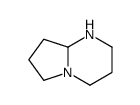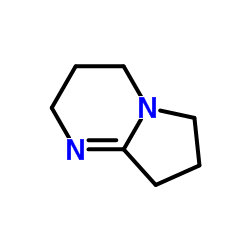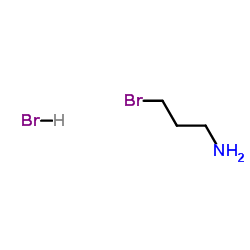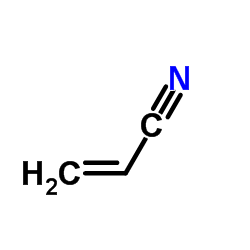7663-77-6
| 中文名 | 1-(3-氨基丙基)-2-吡咯烷酮 |
|---|---|
| 英文名 | N-(3‘-Aminopropyl)-2-pyrrolidinone |
| 中文别名 |
N-(3'-氨丙基)-2-吡咯烷酮
N-(3'-丙胺基)-2-吡咯烷酮 N-(3-氨基丙基)-2-吡咯烷酮 |
| 英文别名 |
1-(3-Aminopropyl)-2-pyrrolidinone
EINECS 231-632-7 MFCD00003201 1-(3-Aminopropyl)-2-pyrrolidone 1-(3-aminopropyl)pyrrolidin-2-one |
| 密度 | 1.1±0.1 g/cm3 |
|---|---|
| 沸点 | 312.0±0.0 °C at 760 mmHg |
| 分子式 | C7H14N2O |
| 分子量 | 142.199 |
| 闪点 | 132.4±22.6 °C |
| 精确质量 | 142.110611 |
| PSA | 46.33000 |
| LogP | -0.75 |
| 蒸汽压 | 0.0±0.6 mmHg at 25°C |
| 折射率 | 1.503 |
| 储存条件 | Refrigerator |
| 分子结构 | 1、 摩尔折射率:39.63 2、 摩尔体积(m3/mol):134.0 3、 等张比容(90.2K):342.0 4、 表面张力(dyne/cm):42.3 5、 极化率(10 -24cm 3): 15.71 |
| 计算化学 | 1.疏水参数计算参考值(XlogP):-0.8 2.氢键供体数量:1 3.氢键受体数量:2 4.可旋转化学键数量:3 5.互变异构体数量:2 6.拓扑分子极性表面积46.3 7.重原子数量:10 8.表面电荷:0 9.复杂度:125 10.同位素原子数量:0 11.确定原子立构中心数量:0 12.不确定原子立构中心数量:0 13.确定化学键立构中心数量:0 14.不确定化学键立构中心数量:0 15.共价键单元数量:1 |
| 更多 | 1. 性状:未确定 2. 密度(g/mL 25ºC):1.014 3. 相对蒸汽密度(g/mL,空气=1):未确定 4. 熔点(ºC):154 5. 沸点(ºC,1mmHg):120-123 6. 沸点(ºC,5.2kPa):未确定 7. 折射率(n20/D):1.5 8. 闪点(ºC,0.2mmHg):未确定 9. 比旋光度(º):未确定 10. 自燃点或引燃温度(ºC):未确定 11. 蒸气压(kPa,25ºC):未确定 12. 饱和蒸气压(kPa,60ºC):未确定 13. 燃烧热(KJ/mol):未确定 14. 临界温度(ºC):未确定 15. 临界压力(KPa):未确定 16. 油水(辛醇/水)分配系数的对数值(25℃):未确定 17. 爆炸上限(%,V/V):未确定 18. 爆炸下限(%,V/V):未确定 19. 溶解性(mg/mL):水:未确定 |
Synonym:None Section 2 - COMPOSITION, INFORMATION ON INGREDIENTS
Risk Phrases: None Listed. Section 3 - HAZARDS IDENTIFICATION EMERGENCY OVERVIEW
The toxicological properties of this material have not been fully investigated. Potential Health Effects Eye: May cause eye irritation. The toxicological properties of this material have not been fully investigated. Skin: May cause skin irritation. The toxicological properties of this material have not been fully investigated. Ingestion: May cause irritation of the digestive tract. The toxicological properties of this substance have not been fully investigated. Inhalation: May cause respiratory tract irritation. The toxicological properties of this substance have not been fully investigated. Chronic: No information found. Section 4 - FIRST AID MEASURES Eyes: Flush eyes with plenty of water for at least 15 minutes, occasionally lifting the upper and lower eyelids. Get medical aid. Skin: Get medical aid. Flush skin with plenty of water for at least 15 minutes while removing contaminated clothing and shoes. Wash clothing before reuse. Ingestion: Never give anything by mouth to an unconscious person. Get medical aid. Do NOT induce vomiting. If conscious and alert, rinse mouth and drink 2-4 cupfuls of milk or water. Inhalation: Remove from exposure and move to fresh air immediately. If not breathing, give artificial respiration. If breathing is difficult, give oxygen. Get medical aid. Notes to Physician: Section 5 - FIRE FIGHTING MEASURES General Information: As in any fire, wear a self-contained breathing apparatus in pressure-demand, MSHA/NIOSH (approved or equivalent), and full protective gear. During a fire, irritating and highly toxic gases may be generated by thermal decomposition or combustion. Use water spray to keep fire-exposed containers cool. Vapors may be heavier than air. They can spread along the ground and collect in low or confined areas. Containers may explode when heated. Extinguishing Media: Use agent most appropriate to extinguish fire. Cool containers with flooding quantities of water until well after fire is out. Use water spray, dry chemical, carbon dioxide, or appropriate foam. Section 6 - ACCIDENTAL RELEASE MEASURES General Information: Use proper personal protective equipment as indicated in Section 8. Spills/Leaks: Avoid runoff into storm sewers and ditches which lead to waterways. Clean up spills immediately, observing precautions in the Protective Equipment section. Remove all sources of ignition. Absorb spill using an absorbent, non-combustible material such as earth, sand, or vermiculite. Do not use combustible materials such as sawdust. Provide ventilation. Section 7 - HANDLING and STORAGE Handling: Wash thoroughly after handling. Remove contaminated clothing and wash before reuse. Use with adequate ventilation. Avoid contact with eyes, skin, and clothing. Keep container tightly closed. Avoid ingestion and inhalation. Storage: Store in a tightly closed container. Store in a cool, dry, well-ventilated area away from incompatible substances. Section 8 - EXPOSURE CONTROLS, PERSONAL PROTECTION Engineering Controls: Use adequate ventilation to keep airborne concentrations low. Exposure Limits CAS# 7663-77-6: Personal Protective Equipment Eyes: Wear appropriate protective eyeglasses or chemical safety goggles as described by OSHA's eye and face protection regulations in 29 CFR 1910.133 or European Standard EN166. Skin: Wear appropriate protective gloves to prevent skin exposure. Clothing: Wear appropriate protective clothing to prevent skin exposure. Respirators: Follow the OSHA respirator regulations found in 29 CFR 1910.134 or European Standard EN 149. Use a NIOSH/MSHA or European Standard EN 149 approved respirator if exposure limits are exceeded or if irritation or other symptoms are experienced. Section 9 - PHYSICAL AND CHEMICAL PROPERTIES Physical State: Liquid Color: clear, colorless Odor: Not available. pH: Not available. Vapor Pressure: Not available. Viscosity: Not available. Boiling Point: 120.0 - 123.0 deg C @ 1.00mm Freezing/Melting Point: Not available. Autoignition Temperature: Not available. Flash Point: > 112 deg C (> 233.60 deg F) Explosion Limits, lower: Not available. Explosion Limits, upper: Not available. Decomposition Temperature: Solubility in water: Specific Gravity/Density: 1.0140g/cm3 Molecular Formula: C7H14N2O Molecular Weight: 142.20 Section 10 - STABILITY AND REACTIVITY Chemical Stability: Stable under normal temperatures and pressures. Conditions to Avoid: Incompatible materials, excess heat, strong oxidants. Incompatibilities with Other Materials: Oxidizing agents. Hazardous Decomposition Products: Nitrogen oxides, carbon monoxide, irritating and toxic fumes and gases, carbon dioxide. Hazardous Polymerization: Has not been reported Section 11 - TOXICOLOGICAL INFORMATION RTECS#: CAS# 7663-77-6: UY5739500 LD50/LC50: Not available. Carcinogenicity: N-(3'-Aminopropyl)-2-Pyrrolidinone - Not listed by ACGIH, IARC, or NTP. Other: See actual entry in RTECS for complete information. Section 12 - ECOLOGICAL INFORMATION Section 13 - DISPOSAL CONSIDERATIONS Dispose of in a manner consistent with federal, state, and local regulations. Section 14 - TRANSPORT INFORMATION IATA Not regulated as a hazardous material. IMO Not regulated as a hazardous material. RID/ADR Not regulated as a hazardous material. Section 15 - REGULATORY INFORMATION European/International Regulations European Labeling in Accordance with EC Directives Hazard Symbols: Not available. Risk Phrases: Safety Phrases: S 24/25 Avoid contact with skin and eyes. S 28A After contact with skin, wash immediately with plenty of water. S 37 Wear suitable gloves. S 45 In case of accident or if you feel unwell, seek medical advice immediately (show the label where possible). WGK (Water Danger/Protection) CAS# 7663-77-6: No information available. Canada None of the chemicals in this product are listed on the DSL/NDSL list. CAS# 7663-77-6 is not listed on Canada's Ingredient Disclosure List. US FEDERAL TSCA CAS# 7663-77-6 is not listed on the TSCA inventory. It is for research and development use only. SECTION 16 - ADDITIONAL INFORMATION N/A |
|
生态学数据: 其它有害作用:该物质对环境可能有危害,对水体应给予特别注意 CHEMICAL IDENTIFICATION
HEALTH HAZARD DATAACUTE TOXICITY DATA
|
| 符号 |

GHS05 |
|---|---|
| 信号词 | Danger |
| 危害声明 | H314 |
| 警示性声明 | P280-P305 + P351 + P338-P310 |
| 个人防护装备 | Faceshields;full-face respirator (US);Gloves;Goggles;multi-purpose combination respirator cartridge (US);type ABEK (EN14387) respirator filter |
| 危害码 (欧洲) | C,Xi |
| 风险声明 (欧洲) | R34 |
| 安全声明 (欧洲) | S26-S27-S36/37/39-S45 |
| 危险品运输编码 | UN 3267 8/PG 2 |
| WGK德国 | 3 |
| RTECS号 | UY5739500 |
| 危险类别 | 8.0 |
| 海关编码 | 2933790090 |
|
~87% 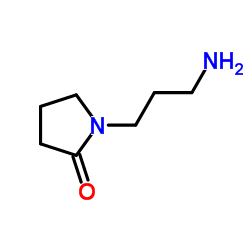
7663-77-6 |
| 文献:Tetrahedron Letters, , vol. 38, # 24 p. 4315 - 4318 |
|
~% 
7663-77-6 |
| 文献:Amino Acids, , vol. 40, # 1 p. 197 - 204 |
|
~% 
7663-77-6 |
| 文献:Tetrahedron, , vol. 53, # 51 p. 17449 - 17460 |
|
~% 
7663-77-6 |
| 文献:Tetrahedron, , vol. 53, # 51 p. 17449 - 17460 |
|
~% 
7663-77-6 |
| 文献:Chemical and Pharmaceutical Bulletin, , vol. 56, # 7 p. 894 - 896 |
|
~% 
7663-77-6 |
| 文献:Justus Liebigs Annalen der Chemie, , vol. 596, p. 1,211 |
| 海关编码 | 2933790090 |
|---|---|
| 中文概述 | 2933790090 其他内酰胺. 增值税率:17.0% 退税率:9.0% 监管条件:无 最惠国关税:9.0% 普通关税:20.0% |
| 申报要素 | 品名, 成分含量, 用途, 乌洛托品请注明外观, 6-己内酰胺请注明外观, 签约日期 |
| Summary | 2933790090. other lactams. VAT:17.0%. Tax rebate rate:9.0%. . MFN tariff:9.0%. General tariff:20.0% |




